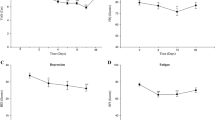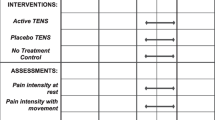Abstract
Fibromyalgia is characterized by a range of symptoms that include muscle pain, fatigue and sleep disorders. Transcutaneous electrical nerve stimulation (TENS) is an established method for pain relief. The purpose of the study was to evaluate the effectiveness and safety of the use of two simultaneously new TENS devices for fibromyalgia pain. After Ethics approval and informed consent, 39 patients were prospectively divided into three groups to evaluate TENS device, applied simultaneously in each patient: (1) at the lower back (perpendicular to the vertebrae canal, at the level of the 5th lumbar vertebrae) and (2) centrally above and below the space between the C7 and T1 spinous processes. The devices were applied for 20 min at 12-h interval during 7 consecutive days. For the placebo group (PG), the devices did not transmitted electrical stimulus. The single-TENS group (STG) (n = 13) had one active and one placebo TENS. The DTG applied both active TENS devices at the low back and cervical areas. Diclofenac was used as rescue analgesic. The efficacy measures were pain relief, reduction in use of daily analgesic tablets, quality of sleep and fatigue. The evaluation within groups revealed that patients from DPG refereed no pain relief when compared to their previous VAS pain score (8 cm, p > 0.05), while patients from the STG refereed improvement of 2.5 cm in the pain VAS (previous 8.5 cm compared to 6 cm after treatment) (p < 0.05), and the DPG refereed daily maintained reduction of 4 cm in the VAS pain (previous 8.5–4.3 cm) (p < 0.02). Concurrent daily consumption of analgesic tablets was reduced in both STG (p < 0.05) and DTG (p < 0.02). Comparison among groups revealed that analgesia, as well as quality of sleep and disposition, was DTG > STG > PG (p < 0.05). Participants subjectively found the active device useful. While the application of a single active TENS improved pain relief in fibromyalgia pain, pain and fatigue were further improved when two active devices were simultaneously applied at the low back and cervical area, with no side effects.




Similar content being viewed by others
References
Clauw DJ (2009) Fibromyalgia: an overview. Am J Med 122(S12):S3–S13
Staud R (2011) Brain imaging in fibromyalgia syndrome. Clin Exp Rheumatol 29(S69):S109–S117
Staud R, Craggs JG, Perlstein WM, Robinson ME, Price DD (2008) Brain activity associated with slow temporal summation of C-fiber evoked pain in fibromyalgia patients and healthy controls. Eur J Pain 12(8):1078–1089
van Wilgen CP, Keizer D (2012) The sensitization model to explain how chronic pain exists without tissue damage. Pain Manag Nurs 13(1):60–65
Ottawa Panel (2004) Ottawa Panel evidence based clinical practice guidelines for electrotherapy and thermotherapy interventions in the management of rheumatoid arthritis in adults. Phys Ther 84(11):1016–1043
Löfgren M, Norrbrink C (2009) Pain relief in women with fibromyalgia: a cross-over study of superficial warmth stimulation and transcutaneous electrical nerve stimulation. J Rehabil Med 41(7):557–562
Mutlu B, Paker N, Bugdayci D, Tekdos D, Kesiktas N et al (2012) Efficacy of supervised exercise combined with transcutaneous electrical nerve stimulation in women with fibromyalgia: a prospective controlled study. Rheumatol Int [Epub ahead of print]
Plazier M, Vanneste S, Dekelver I, Thimineur M, De Ridder D (2011) Peripheral nerve stimulation for fibromyalgia. Prog Neurol Surg 24:133–146
Wolfe F, Smythe HA, Yunus MB, Bennett RM, Bombardier C, Goldenberg DL et al (1990) The American college of rheumatology criteria for the classification of fibromyalgia. Report of the multicenter criteria committee. Arthritis Rheum 33(2):160–172
Di Franco M, Iannuccelli C, Bazzichi L, Atzeni F, Consensi A, Salaffi F, Pietropaolo M, Alessandri C, Basili S, Olivieri M, Bombardieri S, Valesini G, Sarzi-Puttini P (2011) Misdiagnosis in fibromyalgia: a multicentre study. Clin Exp Rheumatol 29(6 S 69):S104–S108
Finckh A, Morabia A, Deluze C, Vischer T (1998) Validation of questionnaire-based response criteria of treatment efficacy in the fibromyalgia syndrome. Arthritis Care Res 11(2):116–123
Dexter F, Chestnut DH (1995) Analysis of statistical tests to compare visual analog scale measurements among groups. Anesthesiology 82:896–902
Cavalcante AB, Sauer JF, Chalot SD, Assumpção A, Lage LV, Matsutani LA (2006) A prevalência de fibromialgia: uma revisão de literatura. Rev Bras Reumatol 46(1):40–48
Lyon P, Cohen M, Quintner J (2011) An evolutionary stress-response hypothesis for chronic widespread pain (fibromyalgia syndrome). Pain Med 12(8):1167–1178
Burgmer M, Pfleiderer B, Maihöfner C, Gaubitz M, Wessolleck E, Heuft G, Pogatzki-Zahn E (2012) Cerebral mechanisms of experimental hyperalgesia in fibromyalgia. Eur J Pain 16(5):636–647
Sarzi-Puttini P, Atzeni F, Cazzola M (2010) Neuroendocrine therapy of fibromyalgia syndrome: an update. Ann NY Acad Sci 1193:91–97
Schmechel DE, Edwards CL (2012) Fibromyalgia, mood disorders, and intense creative energy: A1AT polymorphisms are not always silent. Neurotoxicology 33(6):1454–1472
Ido CS, Rothenbühler R, Janz Júnior LL (2003) Eletroestimulação nervosa transcutânea de baixa frequência nos tender points dos pacientes fibromiálgicos juvenis. Rev Fisioter Univ São Paulo 10(1):1–6
Citak-Karakaya I, Akbayrak T, Demirtürk F, Ekici G, Bakar Y (2006) Short and long-term results of connective tissue manipulation and combined ultrasound therapy in patients with fibromyalgia. J Manipulative Physiol Ther 29(7):524–528
Sampson M, Rome JD, Rummans TA (2006) Slow-frequency RTMS reduces fibromyalgia pain. Pain Med 7(2):115–118
Lichtbroun AS, Raicer MM, Smith RB (2001) The treatment of fibromyalgia with cranial electrotherapy stimulation. J Clin Rheumatol 7(2):72–78
Fregni F, Gimenes R, Valle AC, Ferreira MJ, Rocha RR, Natalle L et al (2006) A randomized, sham-controlled, proof of principle study of transcranial direct current Stimulation for the treatment of pain in fibromyalgia. Arthritis Rheum 54(12):3988–3998
Roizenblatt S, Fregni F, Gimenez R, Wetzel T, Rigonatti SP, Tufik S et al (2007) Site-specific effects of transcranial direct current stimulation on sleep and pain in fibromyalgia: a randomized, sham-controlled study. Pain Pract 7(4):297–306
Kim HW, Roh DH, Yoon SY, Kang SY, Kwon YB, Han HJ, Lee HJ, Choi SM, Ryu YH, Beitz AJ, Lee JH (2006) The anti-inflammatory effects of low- and high-frequency electroacupuncture are mediated by peripheral opioids in a mouse air pouch inflammation model. J Altern Complement Med 12(1):39–44
Kim HW, Uh DK, Yoon SY, Roh DH, Kwon YB, Han HJ, Lee HJ, Beitz AJ, Lee JH (2008) Low-frequency electroacupuncture suppresses carrageenan-induced paw inflammation in mice via sympathetic post-ganglionic neurons, while high-frequency EA suppression is mediated by the sympathoadrenal medullary axis. Brain Res Bull 75(5):698–705
Moldofsky H, Harris HW, Archambault WT, Kwong T, Lederman S (2011) Effects of bedtime very low dose cyclobenzaprine on symptoms and sleep physiology in patients with fibromyalgia syndrome: a double-blind randomized placebo-controlled study. Rheumatol 38(12):2653–2663
Acknowledgments
The authors acknowledge Medecell Brasil for the donation of the active and placebo TENS devices TANYX.
Author information
Authors and Affiliations
Corresponding author
Rights and permissions
About this article
Cite this article
Lauretti, G.R., Chubaci, E.F. & Mattos, A.L. Efficacy of the use of two simultaneously TENS devices for fibromyalgia pain. Rheumatol Int 33, 2117–2122 (2013). https://doi.org/10.1007/s00296-013-2699-y
Received:
Accepted:
Published:
Issue Date:
DOI: https://doi.org/10.1007/s00296-013-2699-y




